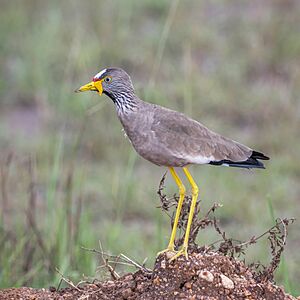African wattled lapwing facts for kids
Quick facts for kids African wattled lapwing |
|
|---|---|
 |
|
| Semuliki Wildlife Reserve, Uganda | |
| Conservation status | |
| Scientific classification | |
| Genus: |
Vanellus
|
| Species: |
senegallus
|
| Synonyms | |
|
Afribyx senegallus (Linnaeus, 1766) |
|
The African wattled lapwing (Vanellus senegallus) is a large bird found in many parts of Africa. It is also known as the Senegal wattled plover or simply wattled lapwing. This bird belongs to a group called lapwings, which are a type of large wader (birds that walk in shallow water). You can find them living in most of sub-Saharan Africa, especially outside of rainforest areas. They sometimes move to different places depending on the season.
Contents
About the African Wattled Lapwing
These birds are easy to spot and recognize. They are large, brown wading birds. They have a black crown on their head and a white forehead. One of their most noticeable features is their large, yellow wattles on their face. Wattles are fleshy growths, like small flaps of skin.
Their tail is white with a black tip. They also have long, yellow legs.
What Does It Look Like in Flight?
When the African wattled lapwing flies, you can see its wings clearly. The top part of their wings has black flight feathers. The other parts of the upper wing are brown, with a white bar separating the colors. The underside of their wings is white, but the flight feathers underneath are black.
Its Special Call
The African wattled lapwing has a very loud call. It sounds like a clear peep-peep. This call helps them communicate with other birds.
Where Does It Live and What Does It Eat?
This bird often breeds in wet, low-lying areas. They especially like damp grasslands. You might also see them feeding in drier places, like golf courses. They look for insects and other small creatures on the ground to eat.
When it's time to lay eggs, the female bird makes a simple nest on the ground. This nest is called a "ground scrape." She usually lays three or four eggs in it.
Conservation Efforts
The African wattled lapwing is one of the birds protected by an important agreement. This agreement is called the Agreement on the Conservation of African-Eurasian Migratory Waterbirds (AEWA). This means that countries work together to help protect these birds and their habitats.
Gallery



